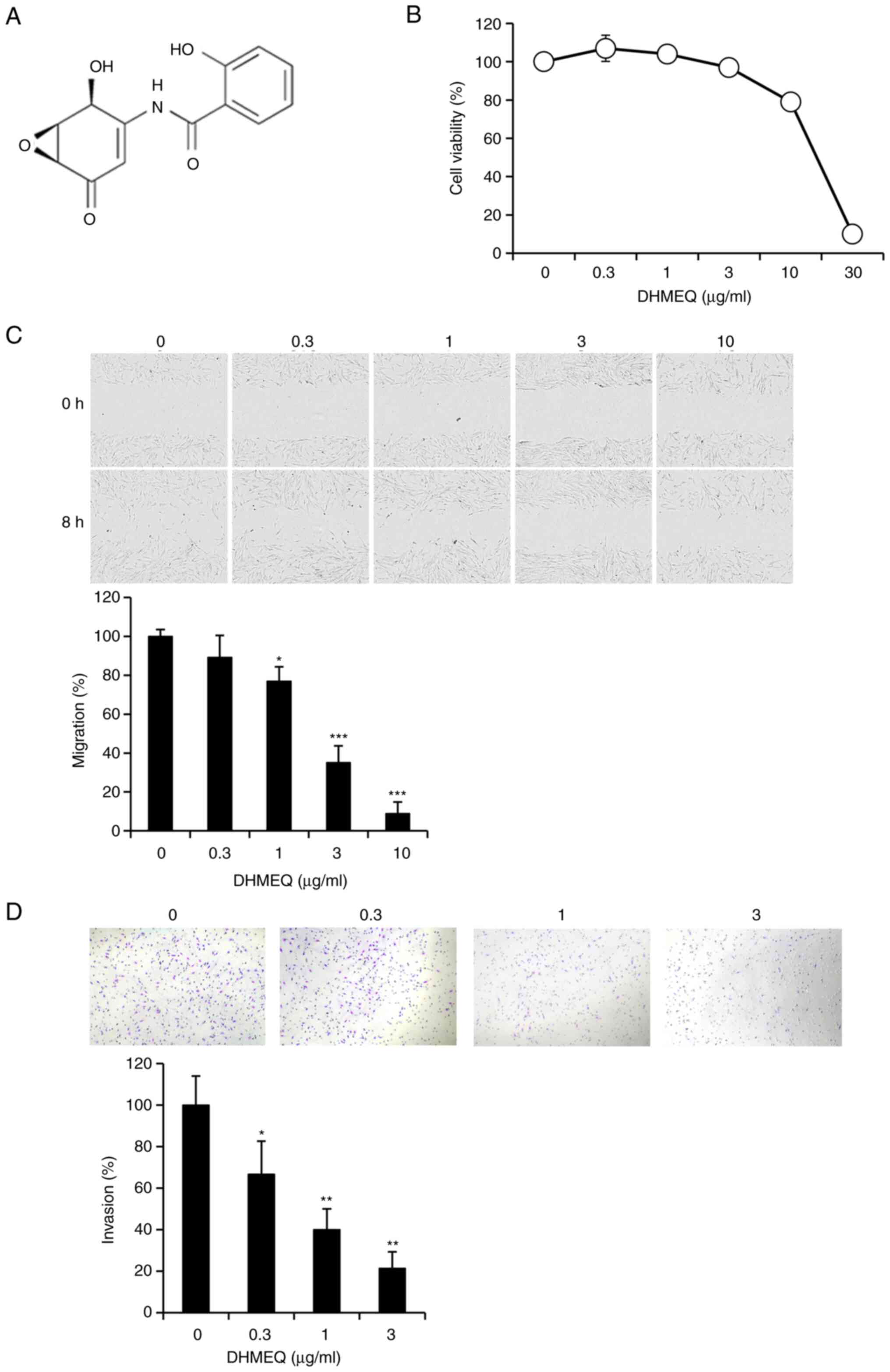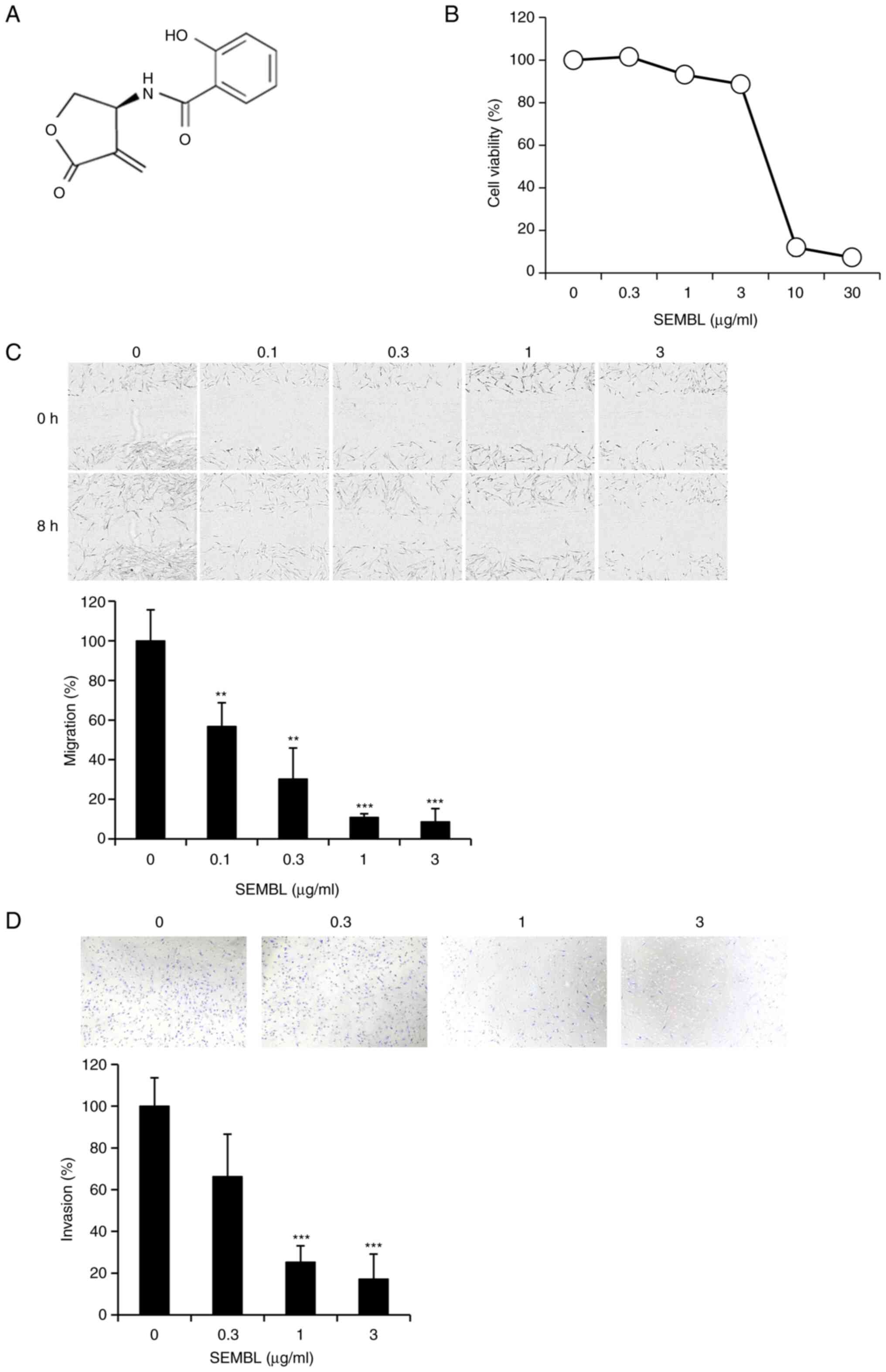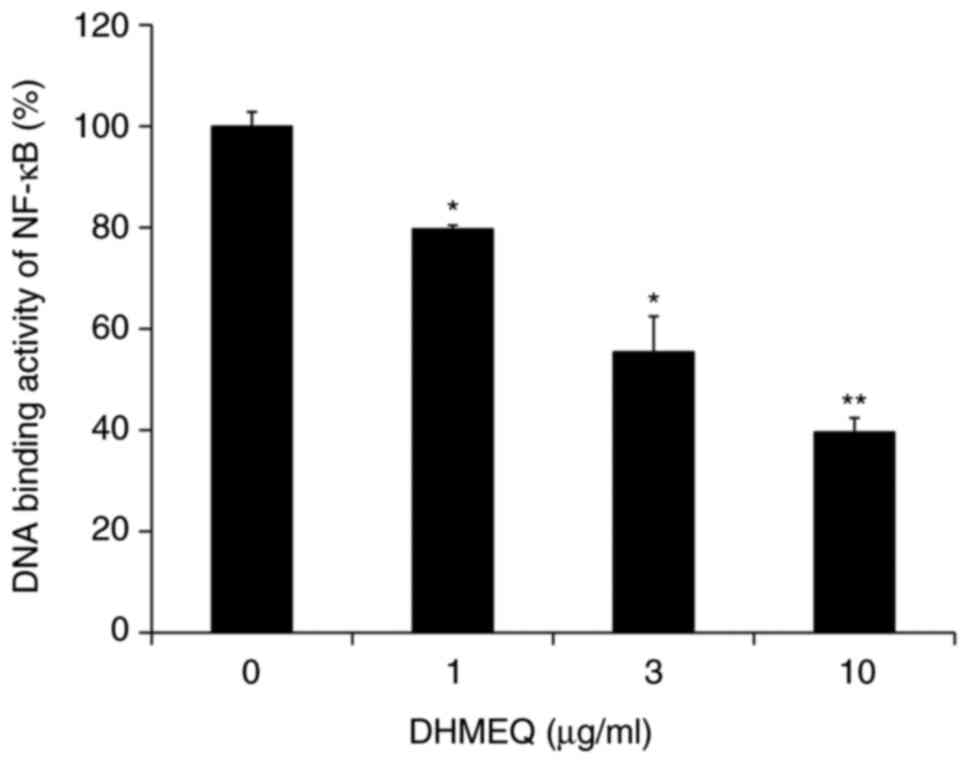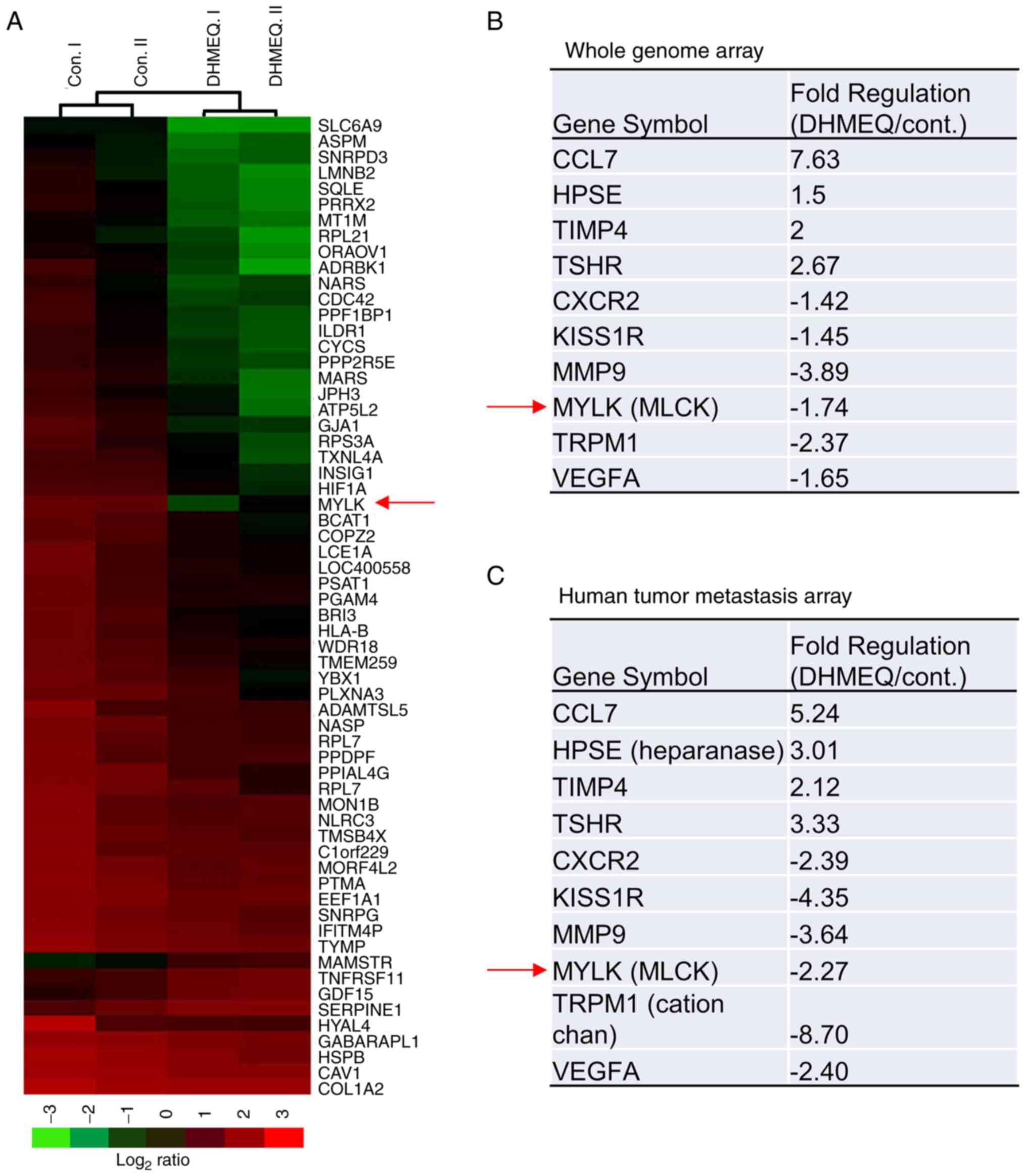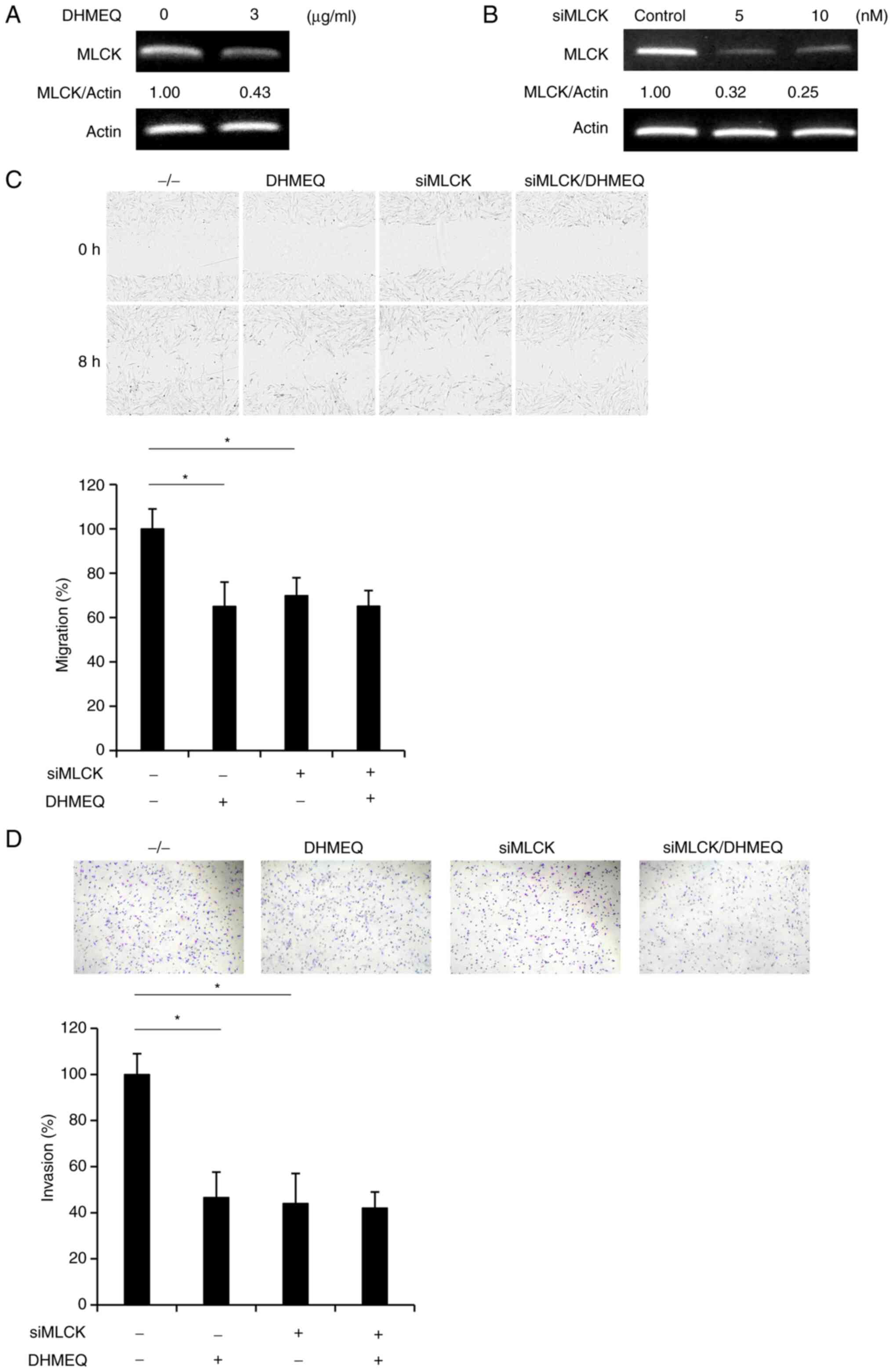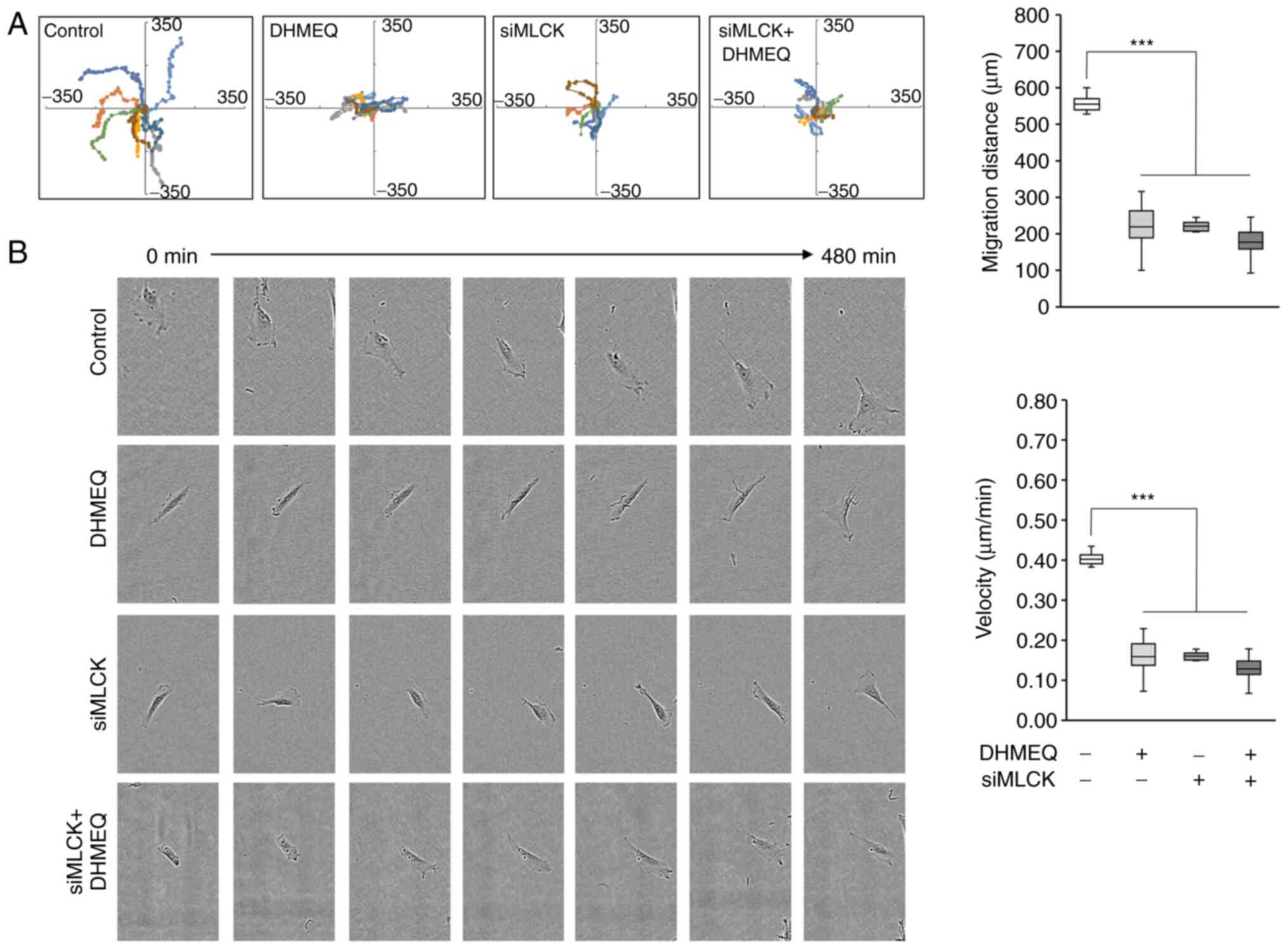Inhibition of MLCK‑mediated migration and invasion in human endometriosis stromal cells by NF‑κB inhibitor DHMEQ
- Authors:
- Published online on: June 9, 2023 https://doi.org/10.3892/mmr.2023.13028
- Article Number: 141
-
Copyright: © Lin et al. This is an open access article distributed under the terms of Creative Commons Attribution License.
Abstract
Introduction
Endometriosis is a disease where the endometrial cells move outside the uterus and grow at a secondary site, causing dysmenorrhea and including abdominal pain. Endometriosis is estimated to affect ~10% of women of reproductive age worldwide (1,2). Current therapy against endometriosis includes anti-inflammatory agents and hormonal therapy (3). Combined oral contraceptives are frequently used by females with endometriosis to decrease the severity of dysmenorrhea. However, the treatment of patients with endometriosis who wish to become pregnant requires a therapy other than hormonal treatment. Therefore, novel chemical drug treatments that may be used for women who wish to become pregnant are required.
There are various types of endometriosis and several theories for its mechanism. Typically, endometrial cells, after shedding from the uterine lining, travel through the fallopian tubes to the ovaries and then to the peritoneal cavity, where they migrate and invade various places such as the pouch of Douglas. They may then attach, grow and cause various symptoms. Therefore, the migration and invasion of endometrial cells are most commonly involved in the mechanism of endometriosis.
Previously, our group found a selective NF-κB inhibitor, dehydroxymethylepoxyquinimicin (DHMEQ), by molecular design based on the structure of a natural compound (4,5). DHMEQ covalently binds to the NF-κB components, such as p65, p50, cRel and RelB, to inhibit mainly the DNA binding activity (6,7). It has been shown to ameliorate various inflammatory (8) and neoplastic (9) disease models through intraperitoneal (IP) administration. In addition, DHMEQ was shown to inhibit inflammatory responses in patient-derived peritoneal cells (10). No toxicity was observed in any of the in vivo experiments. This finding is due to DHMEQ not entering the systemic circulation; it instead acts only in the peritoneal cavity (8).
DHMEQ (Fig. 1A) was reported to inhibit cancer cell migration and invasion in breast cancer cells in 2D and 3D analyses by lowering MMP-2 expression (11,12). It also inhibited invasion of mouse plasmacytoma cells by lowering the expression of the kisspeptin-1 receptor (13). Furthermore, it inhibited the invasion of primary cultured mouse mast cells by lowering MMP-2 expression (14). In addition, intraperitoneal administration of DHMEQ inhibited peritoneal metastasis of human pancreatic cancer cells in mice, possibly by inducing anoikis (15). SEMBL is a stable analogue of DHMEQ and it has also been shown to inhibit migration and invasion of human ovarian carcinoma cells (16).
It may be possible for DHMEQ to inhibit the migration and invasion of endometriosis cells. In the present research, the effect of DHMEQ on the migration and invasion of immortalized human endometriosis stromal cells (HESC) was studied and the mechanisms of the inhibition were investigated.
Materials and methods
Materials
DHMEQ was synthesized in our laboratory as described previously (8,17). Immortalized HESC (cat. no. T0533-C) were purchased from Applied Biological Materials, Inc. These cells possess insulin-like growth factor binding protein-1, prolactin, tissue factor and plasminogen activator inhibitor-1 as markers for decidualization endpoints (Supplier's manual). The cells were grown in Prigrow IV medium (Applied Biological Materials, Inc.), supplemented with 10% charcoal-stripped fetal bovine serum (FBS; Gibco; Thermo Fisher Scientific, Inc.), 100 U/ml penicillin and 100 µg/ml streptomycin (Gibco; Thermo Fisher Scientific, Inc.) in a humidified incubator with 5% CO2 at 37°C.
Cell viability assay
Cells (1×104) were seeded in 96-well microplates and incubated for 24 h. Different concentrations of DHMEQ were then added to each well and the cells incubated for another 24 h. MTT solution (10 µl; Cayman Chemical Company) was added to each well, followed by incubation for 2 h in the incubator. Subsequently, 100 µl of DMSO was added to each well to replace the culture supernatant. After the purple formazan crystals were completely solubilized by DMSO, the absorbance of the samples was measured at 570 nm using a microplate reader (Bio-Rad Laboratories, Inc.).
Wound-healing assay
Cell migration was determined by the wound-healing assay as previously described (18). Cells (1×105) were seeded in a 24-well plate. After the cells became 90% confluent, a uniform scratch wound across the center of each well was made with a 200-µl pipette tip (Rikaken STAR Tips). The cells were then washed twice with serum-free media to remove detached cells and growth media, and the cells were replenished with fresh serum-free media and cultured for 8 h. A phase contrast microscope at (magnification, ×4) was used to record the movement of the cells into the scratched area.
Cell tracking analysis
Approximately 500 cells were seeded in 96-well ImageLock plates (Essen BioScience) precoated with collagen type I (Sigma-Aldrich; Merck KGaA). Images were taken every 15 min continuously for 24 h using an Incucyte ZOOM (Essen BioScience). The trajectories of motile cells were tracked manually using Image J software (Image J 1.53e with Java 1.8.0_172; National Institutes of Health) along with the plugin for manual tracking (Fabrice Cordelieres, Institute Curie) (19).
Matrigel chamber invasion assay
The Matrigel chamber assay was performed as described previously (18). BD Matrigel Basement Membrane Matrix inserts (Corning Inc.) were rehydrated in serum-free medium for 2 h at 37°C. After the rehydration, HESC cells (4×104) suspension in 500 µl serum-free medium containing DHMEQ or DMSO were seeded into the inserts. Inserts were carefully transferred to the 24-well plate filled with 750 µl medium containing 10% FBS and incubated for 24 h at 37°C in an incubator. After the incubation, non-invading cells were removed by scrubbing with a moistened cotton swab from the upper surface of the membrane. Invading cells on the lower surface of the membrane were stained with Diff-Quick (Sysmex Corporation) and counted under a phase contrast microscope (magnification, ×10). Both cell nuclei and the membrane hole were stained in purple. Only the cell nuclei were counted, not the holes.
NF-κB-DNA binding assay
After the treatment with DHMEQ, the nuclear extract was prepared with the Nuclear Extract Kit (Active Motif, Inc.) following the supplier's protocol. DNA binding activity of the extract was measured with the TransAM NF-κB p65 Transcription Factor Assay Kit (Active Motif, Inc.). Nuclear extract (5 µg) and 96-well plates pre-coated with an immobilized oligonucleotide containing the NF-κB consensus site (5′-GGGACTTTCC-3′) were used for the assay. Detection of the DNA binding activity of NF-κB was performed as described previously (20).
Whole-genome array analysis
Whole-genome array analysis was performed as previously described (21). Total RNA was extracted with the RNeasy Mini Kit (Qiagen GmbH) and 250 ng of total RNA was used for cDNA synthesis. The Agilent Low Input Quick Amp Labeling Kit (Agilent Technologies, Inc.) was applied for cDNA synthesis and cRNA labeling with cyanine 3 (Cy3) dye. Cy3-labeled cRNA was purified and quantified with the Nanodrop One (Thermo Fisher Scientific, Inc.). The purified Cy3-labeled cRNA was then fragmented and hybridized on a Human Gene Expression 4× 44K v2 Microarray Chip containing 27,958 Entrez Gene RNAs using a Gene Expression Hybridization kit (Agilent Technologies, Inc.). After the microarray chip was washed twice in gene expression wash buffer, microarray slides were scanned with the Agilent G2565BA Microarray Scanner (International Equipment Trading Ltd.). Raw and normalized microarray data were submitted to the Gene Expression Omnibus database at the National Center for Biotechnology Information (accession no. GSE216255; http://www.ncbi.nlm.nih.gov/geo/query/acc.cgi?acc=GSE216255). Gene set enrichment analysis was performed according to the tutoring [Gene Set Enrichment Analysis (GSEA) User Guide: https://www.gsea-msigdb.org/gsea/doc/GSEAUserGuideFrame.html].
Metastasis PCR array
Total RNA from HESC was purified by spin column using the RNeasy Mini Kit (Qiagen GmbH) and 0.5 µg of total RNA was used for reverse transcription (RT) with the RT2 First Strand Kit (Qiagen GmbH) according to the manufacturer's instructions. The cDNA was added to the qPCR Master Mix (Qiagen GmbH). The PCR components mix was dispensed into the Human Tumor Metastasis PCR Array format (Qiagen GmbH) according to the manufacturer's instructions. Data analysis was accomplished by the comparative Cq method (22).
RNA isolation and semi-quantitative RT-PCR analysis
RNA isolation and semi-quantitative RT-PCR analysis were performed as previously described (18). The primer, number of PCR cycles and the annealing temperature were as follows: Myosin light chain kinase (MLCK), 5′-CAACAGAGAAGACGGTGACCA-3′ (forward) and 5′-TCACAAGGCTGAAAGTCCCC-3′ (reverse), 32 cycles, 58°C; β-actin, 5′-CTTCTACAATGAGCTGCGTG-3′ (forward) and 5′-TCATGAGGTAGTCAGTCAGG-3′ (reverse), 21 cycles, 58°C. PCR products were electrophoresed on 2% agarose gels stained with ethidium bromide and visualized with a UV illuminator (FAS-V; NIPPON Genetics co., Ltd.) and analyzed by Image J 1.53e with Java 1.8.0 _172 (National Institutes of Health).
Knockdown by small interfering (si)RNA
siMLCK (cat. no. sc-365352) and control siRNA-A (cat. no. sc-37007) were purchased from Santa Cruz Biotechnology, Inc. Transfection of siRNAs into cells was carried out using the Lipofectamine® RNAiMax transfection reagent (Thermo Fisher Scientific, Inc.) following the manufacturer's protocols. The mRNA expression of MLCK was analyzed to measure the knockdown efficiency.
Statistical analysis
All experiments were repeated at least three times. Values are expressed as mean ± standard error of the mean. The significance of differences between groups was analyzed by ANOVA followed by Dunnett's post-hoc test and/or the Student's t-test where appropriate. P<0.05 was considered to indicate a statistically significant difference.
Results
Inhibition of cellular migration and invasion by DHMEQ
DHMEQ (Fig. 1A) exhibited no prominent toxicity below 10 µg/ml in HESC (Fig. 1B). Cellular migration was assessed by a wound-healing assay. DHMEQ inhibited the migration of HESC at nontoxic concentrations (Fig. 1C). Cellular invasion was assessed by a Matrigel® chamber assay. DHMEQ inhibited cellular invasion at the nontoxic concentrations (Fig. 1D).
Inhibition of cellular migration and invasion by SEMBL
(S)-β-salicyloylamino-α-exo-methylene-γ-butyrolactone (SEMBL; Fig. 2A) is a stable analog of DHMEQ and it is also known to inhibit DNA binding of the NF-κB component p65 directly (16). SEMBL showed no prominent toxicity below 3 µg/ml in HESC (Fig. 2B). It inhibited the migration of HESC at nontoxic concentrations (Fig. 2C). SEMBL again inhibited cellular invasion at the nontoxic concentrations (Fig. 2D).
Inhibition of cellular NF-κB by DHMEQ
DHMEQ was employed for further mechanistic studies, as it has been more extensively studied in terms of biological activities and is being developed into a drug (8). Endometriosis cells often possess elevated NF-κB (23). Experiments performed by our group have indicated that HESC also possess constitutively activated NF-κB activity (data not shown). DHMEQ inhibited cellular NF-κB activity in HESC (Fig. 3).
Whole genome and metastasis PCR array analyses
Next, the mediator of the inhibition of migration and invasion by DHMEQ was investigated using whole-genome (Fig. 4A and B) and metastasis PCR (Fig. 4C) array analyses. A large number (27,958) of genes were analyzed in the whole-genome array, while a limited number of genes involved in metastasis were analyzed in the metastasis PCR array. Both array analyses were performed with HESC treated with or without 3 µg/ml of DHMEQ for 24 h. The expression of several genes was changed. Of note, both the whole-genome (Fig. 4B) and metastasis PCR (Fig. 4C) analyses indicated a decrease in MLCK expression.
Inhibition of migration and invasion by knockdown of MLCK
Downregulation of MLCK was confirmed by independent semi-quantitative PCR analysis (Fig. 5A). Knockdown of MLCK by siRNA (Fig. 5B) inhibited cellular migration (Fig. 5C) and invasion (Fig. 5D) of HESC. Since the addition of DHMEQ to the MLCK-knockdown cells did not further inhibit migration and invasion, the NF-κB/MLCK pathway was considered to be involved mainly in the mechanism of migration and invasion.
The inhibition of migration was further studied by cell tracking analysis. DHMEQ and knockdown of MLCK both clearly lowered the mean distance of movement (Fig. 6A). Not only the distance but also the speed of movement was lowered by DHMEQ or MLCK knockdown (Fig. 6B). When DHMEQ was added to the siMLCK cells, there was again no further inhibition observed.
Discussion
The present study indicated that NF-κB is involved in the migration and invasion of endometriosis cells. NF-κB activates the transcription of numerous inflammatory cytokines, anti-apoptotic molecules and matrix metalloproteases. Constitutive activation of NF-κB has been demonstrated in endometriotic lesions. Activation of NF-κB in endometriotic cells and environmental macrophages may maintain inflammatory reactions in endometriosis. NF-κB is considered to contribute to the increased ability of endometriotic cells to invade and adhere to the peritoneal surface by regulating the expression of matrix metalloproteases (24). Several factors, including estrogen, progesterone, oxidative stress and noncoding RNAs, may regulate NF-κB signaling in endometriosis (25).
Whole-genome PCR array, metastasis PCR array and siRNA knockdown analyses suggested that MLCK is involved in the mechanism of inhibition. Matrix metalloproteases are often essential for cancer cell migration (11,12), and MMP9 was downregulated in both analyses. Regulation of cellular migration by MLCK has been reported. A critical role of MLCK in cell migration involves regulating the cell membrane tension and protrusion necessary for migration, thereby stabilizing the membrane skeleton through F-actin-binding activity. Phosphorylation by MLCK on Thr18 and Ser19 of MLC has been shown to be critical for the activation of myosin ATPase activity and the contractile functions in smooth muscle and non-muscle cells (25,26). Treatment with MLCK inhibitors resulted in a marked reduction of invasiveness, which was mainly due to reduced cellular motility (27). On the other hand, Chen et al (28) showed that deletion of MLCK increased cellular migration independent of MLCK phosphorylation.
The relationship between NF-κB and MLCK has been studied. Activation of NF-κB induced by TNF-α leads to increased MLCK expression in human pancreatic ductal adenocarcinoma cell lines, resulting in tight junction degradation and high permeability of the cells (29). Inhibitors of NF-κB, such as BAY 11 and sulfasalazine, were found to inhibit TNF-α-induced MLCK upregulation in Caco-2 monolayer cells (30). A subsequent study also suggested that NF-κB would be critical to TNF-α-induced MLCK upregulation (31,32). Furthermore, NF-κB was shown to activate the MLCK promoter (33). It has been reported that there are multiple κB sites in the promoter region of MLCK (34).
Since IP administration of DHMEQ is effective in various in vivo disease models (8,9), DHMEQ IP therapy is being developed for the treatment of inflammation and cancer. This therapy may also be useful for the treatment of endometriosis, particularly for those women who wish to conceive.
Acknowledgements
Not applicable.
Funding
This work was financially supported in part by the Japan Society for the Promotion of Science Kakenhi (grant no. 22H03062) and the Japan Agency for Medical Research and Development (grant no. JP18fk0310118JSPS).
Availability of data and materials
The datasets used and/or analyzed during the current study are available from the corresponding author on reasonable request. Raw and normalized microarray data were submitted to the Gene Expression Omnibus database at the National Center for Biotechnology Information (accession no. GSE216255; http://www.ncbi.nlm.nih.gov/geo/query/acc.cgi?acc=GSE216255).
Authors' contributions
YL, SK, KT, KU and AW contributed to the experimental plan and manuscript preparation. HM and JM contributed to the experimental plan. YL, SK, AI, YM and YT carried out the experiments. All authors read and approved the final manuscript. YL and KU confirm the authenticity of all the raw data.
Ethics approval and consent to participate
Not applicable.
Patient consent for publication
Not applicable.
Competing interests
JM is affiliated with Shenzhen Wanhe Pharmaceutical Company (Shenzhen, China). The Department of Molecular Target Medicine, to which KU belongs, is a fund-donated laboratory. It is supported financially by Shenzhen Wanhe Pharmaceutical Company (Shenzhen, China), Meiji Seika Pharma (Tokyo, Japan), Fukuyu Medical Corporation (Nisshin, Japan) and Brunaise Co., Ltd. (Nagoya, Japan). This study was partly supported by Shenzhen Wanhe Pharmaceutical Company.
References
|
World Health Organization (WHO), . International Classification of Diseases. 11th Revision (ICD-11). Geneva: 2018 | |
|
Zondervan KT, Becker CM and Missmer SA: Endometriosis. N Engl J Med. 382:1244–1256. 2020. View Article : Google Scholar : PubMed/NCBI | |
|
Johnson NP and Hummelshoj L: World endometriosis society montpellier consortium. Consensus on current management of endometriosis. Hum Reprod. 28:1552–1568. 2013. View Article : Google Scholar : PubMed/NCBI | |
|
Matsumoto N, Ariga A, To-e S, Nakamura H, Agata N, Hirano S, Inoue J and Umezawa K: Synthesis of NF-kappaB activation inhibitors derived from epoxyquinomicin C. Bioorg Med Chem Lett. 10:865–869. 2000. View Article : Google Scholar : PubMed/NCBI | |
|
Ariga A, Namekawa J, Matsumoto N, Inoue J and Umezawa K: Inhibition of TNF-α-induced nuclear translocation and activation of NF-κB by dehydroxymethyl-epoxyquinomicin. J Biol Chem. 277:27625–27630. 2002. View Article : Google Scholar | |
|
Yamamoto M, Horie R, Takeiri M, Kozawa I and Umezawa K: Inactivation of nuclear factor kappa B components by covalent binding of (−)-dehydroxymethylepoxyquinomicin to specific cysteine residues. J Med Chem. 51:5780–5788. 2008. View Article : Google Scholar : PubMed/NCBI | |
|
Takeiri M, Horie K, Takahashi D, Watanabe M, Horie R, Simizu S and Umezawa K: Involvement of DNA binding domain in the cellular stability and importin affinity of NF-κB component RelB. Org Biomol Chem. 10:3053–3059. 2012. View Article : Google Scholar : PubMed/NCBI | |
|
Ma J, Zhang Y, Sugai T, Kubota T, Keino H, El-Salhy M, Ozaki M and Umezawa K: Inhibition of cellular and animal inflammatory disease models by NF-κB inhibitor DHMEQ. Cells. 10:22712021. View Article : Google Scholar : PubMed/NCBI | |
|
Umezawa K, Breborowicz A and Gantsev S: Anticancer activity of novel NF-κB inhibitor DHMEQ by intraperitoneal administration. Oncol Res. 28:541–550. 2020. View Article : Google Scholar : PubMed/NCBI | |
|
Sosińska P, Maćkowiak B, Staniszewski R, Umezawa K and Bręborowicz A: Inhibition of NF-κB with dehydroxyepoxiquinomicin modifies function of human peritoneal mesothelial cells. Am J Transl Res. 8:5756–5765. 2016.PubMed/NCBI | |
|
Ukaji T, Lin Y, Okada S and Umezawa K: Inhibition of MMP-2-mediated cellular invasion by NF-κB inhibitor DHMEQ in 3D culture of breast carcinoma MDA-MB-231 cells: A model for early phase of metastasis. Biochem Biophys Res Commun. 485:76–81. 2017. View Article : Google Scholar : PubMed/NCBI | |
|
Umezawa K and Lin Y: Inhibition of matrix metalloproteinase expression and cellular invasion by NF-κB inhibitors of microbial origin. Biochim Biophys Acta Proteins Proteom. 1868:1404122020. View Article : Google Scholar : PubMed/NCBI | |
|
Lin Y, Sidthipong K, Ma J, Koide N, Umezawa K and Kubota T: Designed NF-κB inhibitor, DHMEQ, inhibits KISS1R-mediated invasion and increases drug-sensitivity in mouse plasmacytoma SP2/0 cells. Exp Ther Med. 22:10922021. View Article : Google Scholar : PubMed/NCBI | |
|
Noma N, Asagiri M, Takeiri M, Ohmae S, Takemoto K, Iwaisako K, Simizu S and Umezawa K: Inhibition of MMP-2-mediated mast cell invasion by NF-κB inhibitor DHMEQ in mast cells. Int Arch Allergy Immunol. 166:84–90. 2015. View Article : Google Scholar : PubMed/NCBI | |
|
Sato M, Nakanishi K, Haga S, Fujiyoshi M, Baba M, Mino K, Yimin, Niwa H, Yokoo H, Umezawa K, et al: Anoikis induction and inhibition of peritoneal metastasis of pancreatic cancer cells by a nuclear factor-kappa B inhibitor, (−)-DHMEQ. Oncology Res. 21:333–343. 2014. View Article : Google Scholar | |
|
Sidthipong K, Ma J, Yu W, Wang Y, Kobayashi S, Kishino S, Koide N, Yokochi T, Kato K, Okada S and Umezawa K: Rational design, synthesis and in vitro evaluation of novel exo-methylene butyrolactone salicyloylamide as NF-κB inhibitor. Bioorg Med Chem Lett. 27:562–566. 2017. View Article : Google Scholar : PubMed/NCBI | |
|
Suzuki Y, Sugiyama C, Ohno O and Umezawa K: Preparation and biological activities of optically active dehydroxymethylepoxyquinomicin, a novel NF-κB inhibitor. Tetrahedron. 60:7061–7066. 2004. View Article : Google Scholar | |
|
Lin Y, Chen Y, Ukaji T, Okada S and Umezawa K: Isolation of ketomycin from Actinomycetes as an inhibitor of 2D and 3D cancer cell invasion. J Antibiot (Tokyo). 72:148–157. 2018. View Article : Google Scholar : PubMed/NCBI | |
|
Ito H, Tsunoda T, Riku M, Inaguma S, Inoko A, Murakami H, Ikeda H, Matsuda M and Kasai K: Indispensable role of STIL in the regulation of cancer cell motility through the lamellipodial accumulation of ARHGEF7-PAK1 complex. Oncogene. 39:1931–1943. 2020. View Article : Google Scholar : PubMed/NCBI | |
|
Lin Y, Sidthipong K, Ma J, Koide N, Umezawa K and Kubota T: The designed NF-κB inhibitor, DHMEQ, inhibits KISS1R-mediated invasion and increases drug-sensitivity in mouse plasmacytoma SP2/0 cells. Exp Ther Med. 22:10922021. View Article : Google Scholar : PubMed/NCBI | |
|
Karnan S, Ota A, Murakami H, Rahman ML, Hasan MN, Wahiduzzaman M, Hanamura I, Quang Vu L, Inoko A, Hyodo T, et al: Identification of CD24 as a potential diagnostic and therapeutic target for malignant pleural mesothelioma. Cell Death Discovry. 6:1272020. View Article : Google Scholar : PubMed/NCBI | |
|
Vandesompele J, De Preter K, Pattyn F, Poppe B, Van Roy N, De Paepe A and Speleman F: Accurate normalization of real-time quantitative RT-PCR data by geometric averaging of multiple internal control genes. Genome Biol. 3:RESEARCH00342002. View Article : Google Scholar : PubMed/NCBI | |
|
Banu SK, Lee J, Speights VO Jr, Starzinski-Powitz A and Arosh JA: Selective inhibition of prostaglandin E2 receptors EP2 and EP4 induces apoptosis of human endometriotic cells through suppression of ERK1/2, AKT, NFkappaB, and beta-catenin pathways and activation of intrinsic apoptotic mechanisms. Mol Endocrinol. 23:1291–1305. 2009. View Article : Google Scholar : PubMed/NCBI | |
|
Kaponis A, Uwabe T, Taniguchi F, Ito M, Deura I, Decavalas G, Terakawa N and Harada T: The role of NF-κB in endometriosis. Front Biosci (Schol Ed). 4:1213–1234. 2012.PubMed/NCBI | |
|
Somlyo A and Somlyo A: Signal transduction by G-proteins, rho-kinase and protein phosphatase to smooth muscle and non-muscle myosin II. J Physiol. 522:177–185. 2000. View Article : Google Scholar : PubMed/NCBI | |
|
Tan J, Ravid S and Spudich J: Control of nonmuscle myosins by phosphorylation. Annu Rev Biochem. 61:721–759. 1992. View Article : Google Scholar : PubMed/NCBI | |
|
Tohtong R, Phattarasakul K and Jiraviriyakul A: Dependence of metastatic cancer cell invasion on MLCK-catalyzed phosphorylation of myosin regulatory light chain. Prostate Cancer Prostatic Dis. 6:212–216. 2003. View Article : Google Scholar : PubMed/NCBI | |
|
Chen C, Tao T, Wen C, He W, Qiao Y, Gao Y, Chen X, Wang P, Chen C, Zhao W, et al: Myosin light chain kinase (MLCK) regulates cell migration in a myosin regulatory light chain phosphorylation-independent mechanism. J Biol Chem. 289:28478–28488. 2014. View Article : Google Scholar : PubMed/NCBI | |
|
Su Z, Gong Y, Yang H, Deng D and Liang Z: Activation of the nuclear factor-kappa B signaling pathway damages the epithelial barrier in the human pancreatic ductal adenocarcinoma cell line HPAF-II. Pancreas. 48:1380–1385. 2019. View Article : Google Scholar : PubMed/NCBI | |
|
Wang F, Graham W, Wang Y, Witkowski E, Schwarz B and Turner J: Interferon-gamma and tumor necrosis factor-alpha synergize to induce intestinal epithelial barrier dysfunction by up-regulating myosin light chain kinase expression. Am J Pathol. 166:409–419. 2005. View Article : Google Scholar : PubMed/NCBI | |
|
Ma T, Boivin M, Ye D, Pedram A and Said H: Mechanism of TNF-(alpha) modulation of Caco-2 intestinal epithelial tight junction barrier: Role of mysion light-chanin kinase protein expression. Am J Physiol Gastrointest Liver Physiol. 288:G422–G430. 2005. View Article : Google Scholar : PubMed/NCBI | |
|
Ma T, Iwamoto G, Hoa N, Akotia V, Pedram A, Boivin M and Said H: TNF-alpha-induced increase in intestinal epithelial tight junction permeability requires NF-kappa b activation. Am J Physiol Gastrointest Liver Physiol. 286:G367–G376. 2004. View Article : Google Scholar : PubMed/NCBI | |
|
Graham W, Wang F, Clayburgh D, Cheng J, Yoon B, Wang Y, Lin A and Turner J: Tumor necrosis factor-induced long myosin light chain kinase transcription is regulated by differentiation-dependent signaling events. Characterization of the human long myosin light chain kinase promoter. J Biol Chem. 281:26205–26215. 2006. View Article : Google Scholar : PubMed/NCBI | |
|
Ye D and Ma TY: Cellular and molecular mechanisms that mediate basal and tumour necrosis factor-alpha-induced regulation of myosin light chain kinase gene activity. J Cell Mol Med. 12:1331–1346. 2008. View Article : Google Scholar : PubMed/NCBI |



